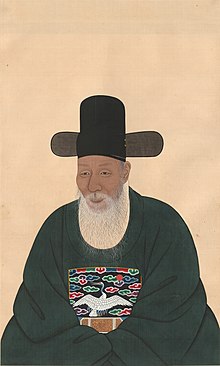Kim Jang-saeng
This article has multiple issues. Please help improve it or discuss these issues on the talk page. (Learn how and when to remove these template messages)
|
| Kim Jang-saeng | |
 | |
| Korean name | |
|---|---|
| Hangul | 김장생 |
| Hanja | |
| Revised Romanization | Gim Jang-saeng |
| McCune–Reischauer | Kim Chang-saeng |
| Art name | |
| Hangul | 사계 |
| Hanja | |
| Revised Romanization | Sagye |
| McCune–Reischauer | Sagye |
| Courtesy name | |
| Hangul | 희원, 희지 |
| Hanja | |
| Revised Romanization | Huiwon, Huiji |
| McCune–Reischauer | Hŭiwŏn, Huiji |
| Posthumous name | |
| Hangul | 문원 |
| Hanja | |
| Revised Romanization | Munwon |
| McCune–Reischauer | Munwŏn |
| Clan Origin | |
| Hangul | 광산 |
| Hanja | |
| Revised Romanization | Gwangsan |
| McCune–Reischauer | Kwangsan |
Kim Jang-saeng (July 8, 1548 - August 3, 1631)[1] was a Neo-Confucian scholar, politician, educator, and writer of Korea's Joseon period.[2] He was the son of Kim Gye-hui (김계휘, 金繼輝), who was the Censor-General during the reign of King Seonjo and his mother was from the Pyeongsan Shin clan (평산신씨, 平山申氏), the daughter of Shin Yeong (신영, 申瑛). He's one of the famous members of the Gwangsan Kim clan and he was put in the Confucian shrine where he was honored as a Munmyo Bae-hyang (문묘배향) sage-scholar.[3] Thus, he became one of the 18 sages of Korea (동방 18 현).
He was successor to the Neo-Confucian academic tradition of Yulgok Yi I (이이) and Seong Hon (성혼).

Kim Jang-saeng was the father of Kim Jip, an eminent Neo-Confucian scholar of the Joseon dynasty, and great grandfather of Kim Manjung, the author of Guunmong (The Cloud Dream of the Nine) and Sasinam jungi.
See also
- Gwangsan Kim clan
- Kim Jip
- Queen Ingyeong
- Kim Manjung
- Kim Ik-hun
- Song Jun-gil
- Song Si-yeol
- Yun Seon-geo
- Yun Hyu
- Yun Jeung
References
- ^ Joseon Annals, August 9, 1631. No. 2
- ^ Jae-eun Kang The Land of Scholars: Two Thousand Years of Korean Confucianism 2006 "A pioneer of the study on family rites based on the doctrines of Zhu Xi in Joseon was Kim Jang-saeng (金長生, pen name is Sagye 沙溪, 1548-1631), who wrote Garye jimnam (家禮輯覽, Exposition of Family Rites) and belonged to the Giho ..."
- ^ Joseon Annals, February 29, 1717. No. 1
- Daehwan, Noh. "The Eclectic Development of Neo-Confucianism and Statecraft from the 18th to the 19th Century," Korea Journal. Winter 2003.
- Haboush, JaHyun Kim and Martina Deuchler. (1999). Culture and the State in Late Chosŏn Korea. Cambridge: Harvard University Press. ISBN 9780674179820; OCLC 40926015
- Lee, Peter H. (1993). Sourcebook of Korean Civilization, Vol. 1. New York: Columbia University Press. ISBN 9780231079129; ISBN 9780231079143; ISBN 9780231104449; OCLC 26353271
External links
